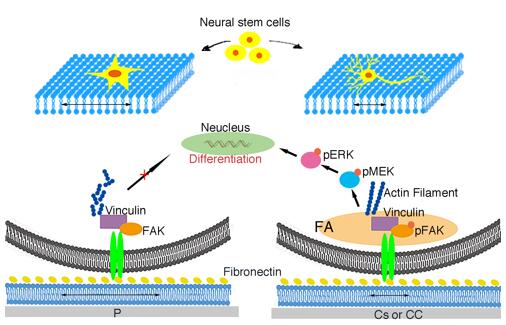Stem cells are unspecialized and have the potential to differentiate into somatic cells, which hold great promising in clinic practices. Extensive studies have been performed to understand how the microenvironment of a stem cell influences its behaviors and functions. In naturally, cells reside in a complex and dynamic extracellular matrix (ECM) environment that has characteristics such as dynamic display of ligands, cell-induced remodeling and no predefined spatial patterns. Tremendous efforts has been made to replicate the ECM, such as modifying materials with bioactive factors and modulating a material's physical characteristics such as stiffness or topography. However, these works are always reported with statically displayed ligands, which cannot mimic the natural dynamic ECM very well.
Supported lipid bilayers (SLBs) are a well-known biomimetic platform because of their similarity to the cell membrane. In particular, SLBs have a long range fluidity, where the lipids can diffuse freely within the membrane so that surface-linked ligands could diffuse freely within membranes to complement cell surface cognate receptors and enable cell-mediated ligand clustering and rearrangement. Thus, the fluidity of SLBs has considerable influence on cell adhesion, cytoskeleton organization, cancer cell invasion potential and so on. However, the effect of the fluidity of SLBs on stem cell fate is not clear.
Recently, Prof. DAI Jianwu’s group from Suzhou Institute of Nano-Tech and Nano-Bionics (SINANO), Chinese Academy of Sciences (CAS), found the behavior of neural stem cells (NSCs) was highly dependent on the fluidity of SLBs. Low fluidity resulted in enhanced focal adhesion (FA) formation, a dense network of stress fibers, stretched and elongated cellular morphology and increased neuronal differentiation, while high fluidity led to less FA formation, immature stress fibers, round cellular morphology and more astrocyte differentiation.
They also revealed that low fluidity may have enhanced FA formation, which activated FAK-MEK/ERK signaling pathways and ultimately promoted neuronal differentiation of NSCs. This work provides a strategy for manipulating the dynamic matrix surface for the development of culture substrates and tissue-engineered scaffolds, which may aid the understanding of how the dynamic ECM influences stem cell behaviors as well as improving the efficacy of stem cell applications.
This work has been published in Biomaterials entitled “Lower fluidity of supported lipid bilayers promotes neuronal differentiation of neural stem cells by enhancing focal adhesion formation”. This work was supported by the National Key R&D Program of China [No. 2016YFC1000809]; the Key Research Program of the Chinese Academy of Sciences [No. ZDRW-ZS-2016-2-3]; the National Natural Science Foundation of China [No. 11274345] and the Ministry of Science and Technology of China [No. 2014CB965003]. 
Figure: Schematic illustration of the SLB fluidity influence the differentiation of NSCs.(Image by SINANO) Contact information:
Prof. DAI Jianwu, CHEN Yanyan, Suzhou Institute of Nano-Tech and Nano-Bionics, Chinese Academy of Sciences
Email: jwdai@genetics.ac.cn, yychen2006@sinano.ac.cn
Reference: https://www.sciencedirect.com/science/article/pii/S0142961218300486 |

